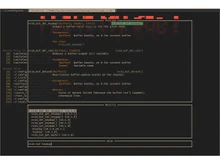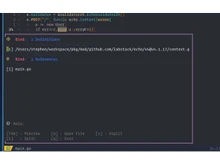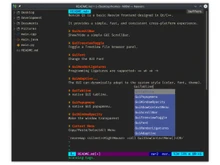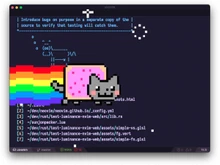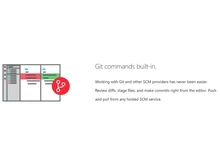Neovim vs VSCode: Which is the Right Code Editor for Your Workflow?
Selecting the right text editor software or integrated development environment (IDE) is important for developers’ productivity. Neovim and Visual Studio Code (VSCode) are two of the most widely discussed website development tools. Each represents a different philosophy and workflow catered to different types of developers.
This detailed comparison, “Neovim vs VSCode,” explores their core strengths, weaknesses, and ideal use cases to help users choose the right tool aligned with their working style and project demands.
Neovim: Lightweight Editor with Limitless Customization
Neovim is a free and open-source text editor. It is a modern take on the classic Vim editor, built to be faster, extensible, and easier to integrate with the latest development tools.
What Makes Neovim Stand Out?
- Performance and Lightweight Nature: Neovim launches in milliseconds (around 100ms even with dozens of plugins), making it exceptionally quick compared to VSCode’s second-long startup. It uses minimal CPU and memory, perfect for older hardware, servers, or quick terminal access during remote development.
- Keyboard-Centric Modal Editing: Neovim uses Vim’s modal editing style, making keyboard-based navigation fast and efficient. It enables selection and editing without the mouse. Users who master this can dramatically accelerate their coding speed and efficiency by keeping their hands on the keyboard and reducing context switches.
- Customization and Extensibility: Neovim allows deep customization through Lua scripting and a rich plugin ecosystem. Developers can craft a tailored environment that fits their exact needs. From language servers to Git integration and debugging, Neovim can be modularized through plugins rather than bundled bloat.
- Terminal-First Experience: Designed primarily for terminal use, Neovim excels in terminal-based workflows, including SSH sessions and remote coding. It offers a consistent and dependable experience outside of graphical desktop environments.
What are some of the challenges with Neovim?
- Steep Learning Curve: Vim’s modal editing system requires an upfront investment to learn keybindings, commands, and configuration files. Beginners may feel overwhelmed by the amount of setup and the deviation from GUI editors.
- Lack of Pre-requisites: Unlike an IDE, Neovim does not come preloaded with GUI-based debugging, Git management, or visual plugins. Features are added through plugins, which require discovery, installation, and occasional maintenance.
- Visual Limitations: For developers accustomed to rich graphical interfaces, Neovim’s textual, terminal interface can feel limiting, especially for visual navigation or inspection of code and errors.
Visual Studio Code (VSCode): User-Friendly Modern IDE
VSCode is created by Microsoft. It strikes a balance between a lightweight editor and a full IDE. This code editor is designed to be accessible yet powerful for a broad range of developers. It functions as a customizable development environment with features like syntax highlighting, intelligent code completion, debugging, and built-in Git version control.
Why VSCode Is a Developer Favorite?
- User-Friendly GUI and Accessibility: VSCode offers a polished graphical user interface with easy installation, an integrated terminal, multi-pane editing, and accessible command palettes that reduce the learning curve drastically.
- Extensive Ecosystem and Extensions: The rich marketplace supports thousands of extensions that add language support, debuggers, themes, and integrations. This enables developers working on any stack (from Python to C++ to frontend frameworks) to get productivity gains immediately.
- Built-in Features: VSCode includes robust code completion (IntelliSense), Git version control integration, debugging tools, and collaborative features (like Live Share), all without heavy manual setup.
- Cross-Platform with Multi-Language Support: It runs natively on Windows, macOS, and Linux, making it a universal tool for diverse teams and multilingual projects.
What are some of the Limitations of VSCode
- Higher Resource Usage: VSCode consumes more CPU and memory, especially when loaded with many extensions or handling large projects. This may lead to lag or longer startup times on low-spec hardware.
- Potential for Overhead and Bloat: The extensive feature set means VSCode can become complex and slower over time as more extensions accumulate, requiring occasional maintenance and performance tuning.
- Keyboard Efficiency: Though VSCode supports Vim keybindings through plugins like VSCodeVim or VSCode-Neovim, the experience can feel less seamless than native Neovim, as there can be slight lag or inconsistencies.
SWOT Analysis: Neovim vs VSCode
| SWOT Analysis of Neovim vs VSCode |
| Aspect |
Neovim |
VSCode |
| Strengths |
- Ultra-fast startup and low resource use.
- Deep keyboard-driven efficiency.
- Highly customizable and extendable.
- Excellent for remote and terminal workflows.
|
- Rich GUI with integrated tools.
- Extensive marketplace for easy feature expansion.
- Built-in debugger and Git integration.
- Intuitive for new users and broad use cases.
|
| Weaknesses |
- Steep learning curve for newcomers.
- Minimal default built-in tooling.
- Terminal-only interface limits visual capabilities.
|
- Resource-heavy, slower on low spec.
- Potential bloat from extensions.
- Keyboard-driven editing is less core than Neovim.
- Navigation can be cumbersome without shortcuts.
|
| Opportunities |
- Growing plugin ecosystem for GUI-like tools.
- Bringing modal editing to new audiences.
- Deep integration with remote and lightweight workflows.
|
- Expand Live Share and remote collaboration.
- Optimize performance and resource use.
- Further IDE feature integration and AI assistance.
|
| Threats |
- Intimidating for beginners.
- Competition from lightweight IDEs and advanced IDEs.
|
- Performance issues leading users to alternatives.
- Rising popularity of minimal editors like Neovim and Emacs.
|
Detailed Feature Comparison Table of VSCode vs Neovim
| Comparison of Neovim vs VSCode |
| Feature |
Neovim |
VSCode |
| Editor Type |
Terminal-based modal editor |
Graphical, extensible IDE |
| Startup Speed |
~100 milliseconds (even with plugins) |
Seconds to start, depends on extensions |
| Memory Usage |
Very low |
Moderate to high depending on project size |
| User Interface |
Keyboard-driven, minimal, terminal UI |
Full graphical interface with mouse and keyboard |
| Customization |
Extensive through Lua, Vimscript, and plugins |
Configurable through JSON settings and extensions |
| Language Support |
Via LSP and plugins, configurable |
Native and extension-powered with rich IntelliSense |
| Built-in Debugging |
Plugin-based, requires setup |
Fully integrated debugger |
| Version Control |
Git via plugins like vim-fugitive |
Native Git support with UI |
| Collaboration |
Limited to terminal multiplexing or plugins |
Live Share for real-time collaboration |
| Learning Curve |
High, due to modal editing and config complexity |
Low to moderate, user-friendly |
| Cross-Platform |
Yes (Linux, macOS, Windows) |
Yes (Linux, macOS, Windows) |
| Community & Ecosystem |
Vibrant Vim community with growing Neovim plugins |
Massive, diverse extension marketplace |
| Pricing |
Free/open source; Paid extensions |
Starting at $45 per user/month |
When to Choose Neovim or VSCode?
Choose Neovim when:
- You want speed and low resource usage: Neovim’s blazing-fast startup time and minimal footprint make it ideal when performance or hardware restrictions are a concern.
- You prefer keyboard-centric editing: If you enjoy Vim’s modal editing or wish to learn a powerful way to navigate and manipulate code without ever leaving the keyboard, Neovim unlocks unmatched productivity.
- You often work on remote machines or through terminals: Neovim’s design excels in terminal workflows, including servers, remote containers, and cloud instances, where GUI apps may be impractical.
- You love deep customization: For developers who enjoy crafting their ideal environment via Lua scripting or a vast set of community plugins, Neovim offers unbounded flexibility.
VSCode is a better fit when:
- You need a full-featured IDE out of the box: With integrated debugger, Git, terminal, and built-in language support, VSCode works best for many languages and project types.
- You want graphical UI and visual tools: Developers who prefer mouse navigation, visual diffing, graphical debugging, and rich interface elements find VSCode more approachable.
- You prioritize ease of use and minimal setup: VSCode’s intuitive installation, interface, and extension marketplace mean you can start coding efficiently with little configuration.
- You work in large teams or require collaborative coding: VSCode’s Live Share enables real-time pairing and group collaboration, improving team productivity.
How to Tailor Code Editor to Your Workflow?
Here are some recommendations for developers who want to tailor Neovim and Visual Studio Code as per their workflows:
- Beginner or Multi-language Developers: VSCode offers a gentle learning curve and cross-language features, making it ideal for those new to development or juggling projects in different languages.
- Power Users and Vim Enthusiasts: Neovim is hard to beat in speed, customizability, and terminal integration. Invest time in learning Vim commands, and Neovim can reward you with extreme efficiency.
- Hybrid Workflows: Many developers combine both tools. You can use VSCode for heavyweight debugging and UI tasks, and Neovim for quick edits, remote work, or efficient text manipulation.
- System Constraints: On low-powered machines or when working remotely, where every byte of speed counts, Neovim provides an excellent solution to keep you productive.
Techjockey's Verdict
Choosing between Neovim and VSCode ultimately comes down to your workflow, preferences, and project requirements. Both text editors enjoy passionate communities and continuous development. Exploring both will enrich your understanding of coding environments before settling on the best fit.
If deeply customizing your workflow and speed are your priorities, Neovim is compelling. If you seek a feature-rich, approachable, and collaborative environment, VSCode often reigns supreme.
Still confused about which website development tool to choose? Feel free to ask for software advice, configuration tips, plugin recommendations, or workflow integrations for any tool. Connect with the Techjockey Team today!


 4 Ratings & 4 Reviews
4 Ratings & 4 Reviews


